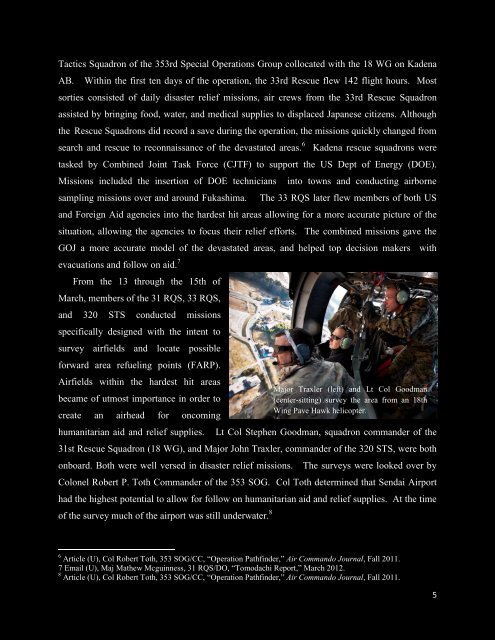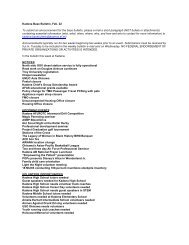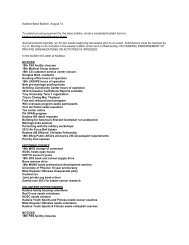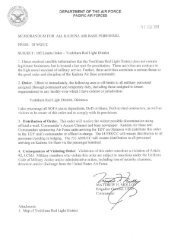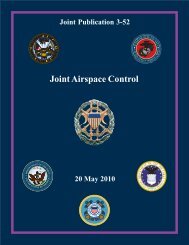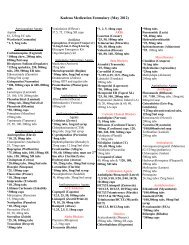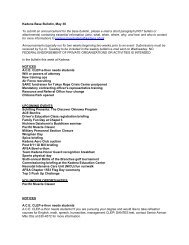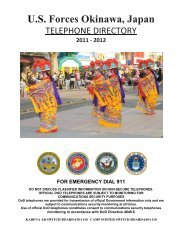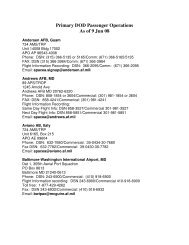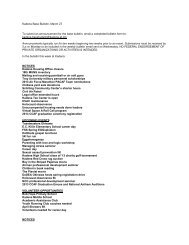TEAM KADENA & OPERATION TOMODACHI ... - Kadena Air Base
TEAM KADENA & OPERATION TOMODACHI ... - Kadena Air Base
TEAM KADENA & OPERATION TOMODACHI ... - Kadena Air Base
Create successful ePaper yourself
Turn your PDF publications into a flip-book with our unique Google optimized e-Paper software.
Tactics Squadron of the 353rd Special Operations Group collocated with the 18 WG on <strong>Kadena</strong><br />
AB.<br />
Within the first ten days of the operation, the 33rd Rescue flew 142 flight hours. Most<br />
sorties consisted of daily disaster relief missions, air crews from the 33rd Rescue Squadron<br />
assisted by bringing food, water, and medical supplies to displaced Japanese citizens. Although<br />
the Rescue Squadrons did record a save during the operation, the missions quickly changed from<br />
search and rescue to reconnaissance of the devastated areas. 6<br />
<strong>Kadena</strong> rescue squadrons were<br />
tasked by Combined Joint Task Force (CJTF) to support the US Dept of Energy (DOE).<br />
Missions included the insertion of DOE technicians<br />
sampling missions over and around Fukashima.<br />
into towns and conducting airborne<br />
The 33 RQS later flew members of both US<br />
and Foreign Aid agencies into the hardest hit areas allowing for a more accurate picture of the<br />
situation, allowing the agencies to focus their relief efforts. The combined missions gave the<br />
GOJ a more accurate model of the devastated areas, and helped top decision makers with<br />
evacuations and follow on aid. 7<br />
From the 13 through the 15th of<br />
March, members of the 31 RQS, 33 RQS,<br />
and 320 STS conducted missions<br />
specifically designed with the intent to<br />
survey airfields and locate possible<br />
forward area refueling points (FARP).<br />
<strong>Air</strong>fields within the hardest hit areas<br />
became of utmost importance in order to<br />
create an airhead for oncoming<br />
humanitarian aid and relief supplies.<br />
Lt Col Stephen Goodman, squadron commander of the<br />
31st Rescue Squadron (18 WG), and Major John Traxler, commander of the 320 STS, were both<br />
onboard. Both were well versed in disaster relief missions.<br />
The surveys were looked over by<br />
Colonel Robert P. Toth Commander of the 353 SOG. Col Toth determined that Sendai <strong>Air</strong>port<br />
had the highest potential to allow for follow on humanitarian aid and relief supplies. At the time<br />
of the survey much of the airport was still underwater. 8<br />
Major Traxler (left) and Lt Col Goodman<br />
(center-sitting) survey the area from an 18th<br />
Wing Pave Hawk helicopter.<br />
6 Article (U), Col Robert Toth, 353 SOG/CC, “Operation Pathfinder,” <strong>Air</strong> Commando Journal, Fall 2011.<br />
7 Email (U), Maj Mathew Mcguinness, 31 RQS/DO, “Tomodachi Report,” March 2012.<br />
8 Article (U), Col Robert Toth, 353 SOG/CC, “Operation Pathfinder,” <strong>Air</strong> Commando Journal, Fall 2011.<br />
5


